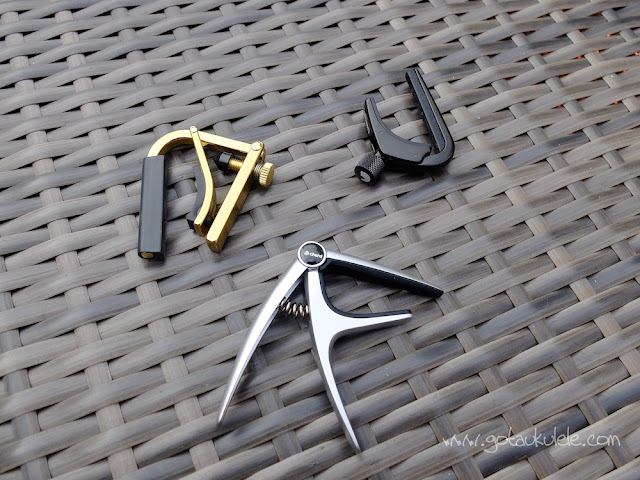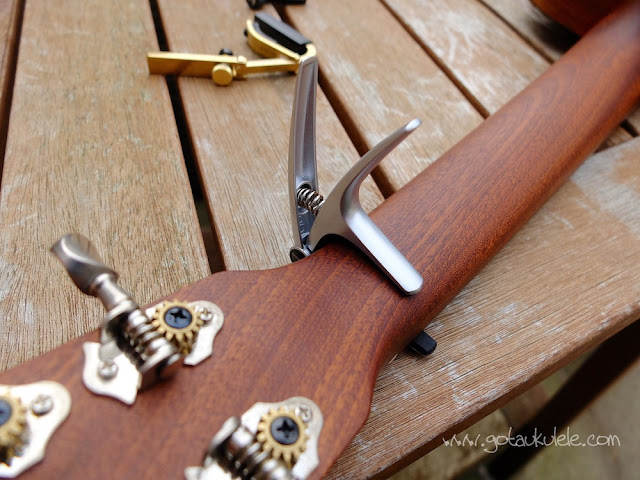An accessory that I haven't really talked much about on Got A Ukulele is the Ukulele Capo.
It's something I am seeing more and more of, so thought it would be good to do a roundup review of the main styles available. |
| Clockwise from top left - Shubb, D'Addario, Chord Trigger |
So what is a capo? Well it's short for 'Capo d'astro / Capotastro' and is a device used on stringed instruments to deliberately shorten the scale length of the instrument. In essence it's a clamp that can be applied to one of the fret spaces to raise the key of the instrument when played open by effectively moving the nut down a selected number of spaces. It's used to transpose a sequence of music up in key whilst allowing the player to use the same chord shapes.
Now, I personally haven't really seen the need for ukulele capos. They are popular on guitar, but then the guitar has a much wider fretboard, is harder to engage the strings and has six of the blighters. On the ukulele however, I've never found it all that complex to use natures own capo - the first finger - to barre the neck and do the same job. But the spirit of Got A Ukulele has never been to tell people that 'you can't do that', and as I say, I am seeing an increasing number of people use capos, and not just beginners either. At the end of the day, they are convenient!
For me, there are various elements to a ukulele capo that are important to take into account.
First thing is the size of the capo. I shudder when I see people saying they use a guitar capo - that would be an incredibly bulky thing to clip on the neck of such a diminutive instrument. In short, you want a capo that doesn't intrude on your left hand technique.
Coupled with that point is weight. I have an intent dislike for ukuleles that are unbalanced and heavy in the neck. If you are playing without a strap, they always feel like the neck is trying to drop to the floor and it's an uncomfortable experience. Adding weight to the neck of an instrument can only cause problems in that regard.
And finally we have to think about ease of use and price... So I've gathered together a few types here that I think represent the most common capos you will find on the market. There are others, but they are all just variations on a theme.
First up is a generic trigger style capo, often referred to as a Kyser (although, in actual fact, a Kyser capo is quite different, but it's the same general principle). This model is made by Chord but these sort of capos really are ten a penny in all sorts of brands, and all do the same thing. It's basically a clip that acts like a clothes peg, with a spring to keep it in the closed position. There are a number of positives with the trigger style capo. They are cheap (this one retails at about £5), they are light (this one is 17 grams) and they are super easy to attach and move up and down the neck. You can even clip them to the headstock when not using them and they naturally fit all depths and profiles of neck without adjustment. I like all of those features, but this sort of style is just not something I can get on with to be honest. You see, when in place and fretting in the low positions with your hand right next to it, I find it gets in the way. Those sharp edges and sticking out bits catch my hand when in use. It's damn annoying. Your mileage may vary as your hand size and technique may have something to do with it of course, but these are not for me.
 |
| Trigger style ukulele capo |
Next up is an old favourite in the guitar world with a ukulele capo made by Shubb. These clip capos have been around on guitars for years, and they are incredibly popular. The simple reason is that they are tough as old boots, simple to use and unobtrusive when in use. So I was delighted to see a ukulele version, which is similarly made. The Shubb uses a clever hinge to lock it in place, but it does take some adjustment of the screw to set it for your particular depth of neck. It's clever though and very well made. That solid construction though comes at a price as they are HEAVY. In fact, this Shubb weighs a whopping 51 grams, which for me is a heck of a lot of weight to be hanging on the neck of your instrument. (EDIT - I have been informed that Shubb make a 'Lite' version of this, but it is still the heaviest of these three at about 28 grams). On the plus side though it's easy to use (though not quite as easy as the trigger style), and when in place is folded down into a small area so it really doesn't interfere with the fretting hand. You may however wince when you realise that the price of around £17... For me though it's all about that weight. A nice idea that is perfect for the guitar, but totally over-engineered for the ukulele I think.
 |
| Shubb ukulele capo |
Finally is the kind of halfway house that is more of your manual style capo. This one is from D'Addario / Planet Waves. At about £17 this is also not cheap, but it's very well made from lightweight aluminium. In fact it's the lightest of the three looked at here, weighing a meagre 14 grams. And in addition to not noticing the weight, when it is in place it takes up so little space that you don't notice it when playing either. In fact it is far smaller than the Shubb. There is a downside though. The D'Addario is attached by adjusting the rear screw to open the capo like a vice, and then tightening it when in place. It means that swift changes of position can be fiddly, and if ever there was a capo that was going to get lost on stage - this is it! It's just not as straightforward to adjust as the other two.
 |
| D'Addario ukulele capo |
So as you can see, there are compromises with all three. Personally I can live with some of those downsides, but weight and the capo interfering with my playing are two that I would want to rule out absolutely. For me then, the D'Addario is the only one I would live with. Sure, it is less user friendly to move about, but when in place it's almost like it isn't there. And that has to be the most important thing I'd say.
Of course, you could also make more of your forefinger, or, if you don't like the cost of these things, revert to the old guitarists trick of placing a stubby pencil on the fret space and looping an elastic band between the two ends around the back of the neck. (Trust me - it works). But seriously, if you don't like capos, that's fine. Don't shoot those that do though - we don't want another strap / plectrum debate...
Video below to see them in action.
VIDEO REVIEW
© Barry Maz



It's light and easy to use, but the best thing about the trigger capo is it's cheap and I don't feel bad that I don't have much use for it. :-/
ReplyDeleteYep - definitely cheap and light.
ReplyDeleteThanks, Barry. Did you consider the Shubb L-9 Lite Capo, evidently half the weight of their standard Capo?
ReplyDeleteYes - Just been told about that one - although it's still twice as heavy as the D'Addario
ReplyDeleteI don't use capos a lot. I prefer to take a couple of ukes in different tunings but I do find them usefu sometimes. The Shubb I find OK on a tenor but not on anything smaller. It gets in the way of my left hand. The Planet Waves is small and light and will work on a soprano. I've found it useful as a quick and easy way to get D-tuning. I also tried a Dunlop one. They're like the pencil and and elastic band and are OK ish. Cheap and not as obtrusive as the Shubb but not as good as the Planet Waves. I've not tried a trigger capo because if I find the Shubb getting in the way of my left hand, how much more so one of these.
ReplyDeleteCapos are not just about not using the finger bar, they are about transposing songs without having to think about what every chord becomes in the new key. They make it easy to change the pitch of the song for singing without having to do all the mental transpositions for each chord.
ReplyDeleteYes, I know that Gary - I just don't think the transpositions are that hard either. I get them for guitar, but there are two extra strings to contend with. But not against them - each to their own!
ReplyDeleteI am surprised that after mentioning the pencil/elastic band trick, you did not mention the TGI elastic capo (sold on Amazon). I guess it may have a limited life but having tried one, although I don't use a capo very often, I found that the lack of a trigger, etc, meant that there was nothing to get in the way of the fretting hand hand. It is inexpensive and relatively easy to move around the neck. And I guess quite light.
ReplyDeleteI use my trigger capo so rarely, I just realized it seems to stay out of the way a bit better when you clamp it from the bottom up. Then I noticed one of the capo ads on your site seems to confirm this way of using it.
ReplyDeleteI use the d'addaro capo. Your right. The can be finicky to move but they don't interfere with playing as much. The downside is the black colour makes it hard to find and lose. This is my second one so someone has an expensive capo. I tied a gold ribbon to the screw of this one for visibility.
ReplyDelete